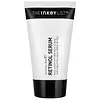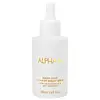What's inside
What's inside
 Key Ingredients
Key Ingredients

 Benefits
Benefits

 Concerns
Concerns

 Ingredients Side-by-side
Ingredients Side-by-side

Water
Skin ConditioningGlycerin
HumectantButylene Glycol
HumectantPropanediol
SolventDicaprylyl Carbonate
EmollientTocopherol
AntioxidantHydroxyethyl Acrylate/Sodium Acryloyldimethyl Taurate Copolymer
Emulsion StabilisingSqualane
EmollientPolysorbate 60
EmulsifyingSorbitan Isostearate
EmulsifyingPhenoxyethanol
PreservativeCaprylyl Glycol
EmollientPhospholipids
Skin ConditioningGlycine Soja Oil
EmollientGlycolipids
Skin ConditioningGlycine Soja Sterols
EmollientRetinyl Acetate
Skin ConditioningDimethicone
EmollientLeuconostoc/Radish Root Ferment Filtrate
AntimicrobialHyaluronic Acid
HumectantDimethyl Isosorbide
SolventHydroxypinacolone Retinoate
Skin ConditioningCarbomer
Emulsion StabilisingPolysorbate 20
EmulsifyingPalmitoyl Tripeptide-1
Skin ConditioningPalmitoyl Tetrapeptide-7
Skin ConditioningSodium Lactate
BufferingTocopheryl Acetate
AntioxidantTetrasodium Glutamate Diacetate
Sodium Hydroxide
BufferingTetrahexyldecyl Ascorbate
AntioxidantWater, Glycerin, Butylene Glycol, Propanediol, Dicaprylyl Carbonate, Tocopherol, Hydroxyethyl Acrylate/Sodium Acryloyldimethyl Taurate Copolymer, Squalane, Polysorbate 60, Sorbitan Isostearate, Phenoxyethanol, Caprylyl Glycol, Phospholipids, Glycine Soja Oil, Glycolipids, Glycine Soja Sterols, Retinyl Acetate, Dimethicone, Leuconostoc/Radish Root Ferment Filtrate, Hyaluronic Acid, Dimethyl Isosorbide, Hydroxypinacolone Retinoate, Carbomer, Polysorbate 20, Palmitoyl Tripeptide-1, Palmitoyl Tetrapeptide-7, Sodium Lactate, Tocopheryl Acetate, Tetrasodium Glutamate Diacetate, Sodium Hydroxide, Tetrahexyldecyl Ascorbate
Water
Skin ConditioningGlycolic Acid 14%
BufferingGlycerin
HumectantButylene Glycol
HumectantPropanediol
SolventDicaprylyl Carbonate
EmollientDimethicone
EmollientPotassium Hydroxide
BufferingCetyl Alcohol
EmollientHydrolyzed Jojoba Esters
Skin ConditioningMethyl Gluceth-20
HumectantSodium Polyacryloyldimethyl Taurate
Emulsion StabilisingTocopherol
AntioxidantHelianthus Annuus Seed Oil
EmollientDimethyl Isosorbide
SolventPhenoxyethanol
PreservativeFerulic Acid
AntimicrobialGlyceryl Stearate
EmollientPEG-100 Stearate
Ammonium Glycyrrhizate
MaskingHibiscus Sabdariffa Flower Extract
Skin ConditioningCaprylyl Glycol
EmollientHydroxypinacolone Retinoate 1%
Skin ConditioningSodium Hyaluronate
HumectantUbiquinone
AntioxidantHippophae Rhamnoides Fruit Extract
Skin ConditioningCodonopsis Lanceolata Extract
AntioxidantEthylhexylglycerin
Skin ConditioningPalmitoyl Tripeptide-5
Skin ConditioningWater, Glycolic Acid 14%, Glycerin, Butylene Glycol, Propanediol, Dicaprylyl Carbonate, Dimethicone, Potassium Hydroxide, Cetyl Alcohol, Hydrolyzed Jojoba Esters, Methyl Gluceth-20, Sodium Polyacryloyldimethyl Taurate, Tocopherol, Helianthus Annuus Seed Oil, Dimethyl Isosorbide, Phenoxyethanol, Ferulic Acid, Glyceryl Stearate, PEG-100 Stearate, Ammonium Glycyrrhizate, Hibiscus Sabdariffa Flower Extract, Caprylyl Glycol, Hydroxypinacolone Retinoate 1%, Sodium Hyaluronate, Ubiquinone, Hippophae Rhamnoides Fruit Extract, Codonopsis Lanceolata Extract, Ethylhexylglycerin, Palmitoyl Tripeptide-5
Ingredients Explained
These ingredients are found in both products.
Ingredients higher up in an ingredient list are typically present in a larger amount.
Butylene Glycol (or BG) is used within cosmetic products for a few different reasons:
Overall, Butylene Glycol is a safe and well-rounded ingredient that works well with other ingredients.
Though this ingredient works well with most skin types, some people with sensitive skin may experience a reaction such as allergic rashes, closed comedones, or itchiness.
Learn more about Butylene GlycolCaprylyl Glycol is a humectant and emollient, meaning it attracts and preserves moisture.
It is a common ingredient in many products, especially those designed to hydrate skin. The primary benefits are retaining moisture, skin softening, and promoting a healthy skin barrier.
Though Caprylyl Glycol is an alcohol derived from fatty acids, it is not the kind that can dry out skin.
This ingredient is also used as a preservative to extend the life of products. It has slight antimicrobial properties.
Learn more about Caprylyl GlycolDicaprylyl Carbonate comes from carbonic acid and caprylyl alcohol, a fatty alcohol. It is an emollient and gives skin a velvet feel. The sources of Dicaprylyl Carbonate may be synthetic or from animals.
As an emollient, Dicaprylyl Carbonate creates a film on the skin. This film traps moisture in, keeping your skin soft and hydrated.
Dimethicone is a type of synthetic silicone created from natural materials such as quartz.
What it does:
Dimethicone comes in different viscosities:
Depending on the viscosity, dimethicone has different properties.
Ingredients lists don't always show which type is used, so we recommend reaching out to the brand if you have questions about the viscosity.
This ingredient is unlikely to cause irritation because it does not get absorbed into skin. However, people with silicone allergies should be careful about using this ingredient.
Note: Dimethicone may contribute to pilling. This is because it is not oil or water soluble, so pilling may occur when layered with products. When mixed with heavy oils in a formula, the outcome is also quite greasy.
Learn more about DimethiconeDimethyl Isosorbide is a low-irritation solvent that helps deliver actives into your skin. It is created from glucose.
Research shows how well this ingredient works depends on the active and formulation rather than the concentration alone. This means adding more Dimethyl Isosorbide does not guarantee better penetration of ingredients into the skin.
Glycerin is already naturally found in your skin. It helps moisturize and protect your skin.
A study from 2016 found glycerin to be more effective as a humectant than AHAs and hyaluronic acid.
As a humectant, it helps the skin stay hydrated by pulling moisture to your skin. The low molecular weight of glycerin allows it to pull moisture into the deeper layers of your skin.
Hydrated skin improves your skin barrier; Your skin barrier helps protect against irritants and bacteria.
Glycerin has also been found to have antimicrobial and antiviral properties. Due to these properties, glycerin is often used in wound and burn treatments.
In cosmetics, glycerin is usually derived from plants such as soybean or palm. However, it can also be sourced from animals, such as tallow or animal fat.
This ingredient is organic, colorless, odorless, and non-toxic.
Glycerin is the name for this ingredient in American English. British English uses Glycerol/Glycerine.
Learn more about GlycerinThis ingredient is a retinoid. It usually goes by a more common name: "Granactive".
Hydroxypinacolone Retinoate (HPR) belongs to the class of retinoids that also includes retinol and tretinoin.
Retinoids have been proven to:
So what is the difference between all the retinoids?
Most retinoids need to go through a conversion line to become effective on skin. The ending product is retinoic acid. Retinoic acid is AKA tretinoin.
HPR is an ester of tretinoin. Emerging studies suggest HPR to have an added benefit that other retinoids don't have: Low irritation.
A study from 2021 found HPR to have the greatest stability when exposed to light and temperature out of all the commercial retinoids.
A note about naming:
The name "Granactive" is the trade name and the name most commonly used on packages.
Granactive is the name of the mixture - about 90% solvent and 10% HPR. A product with 5% granactive has 0.5% HPR.
Learn more about Hydroxypinacolone RetinoatePhenoxyethanol is a preservative that has germicide, antimicrobial, and aromatic properties. Studies show that phenoxyethanol can prevent microbial growth. By itself, it has a scent that is similar to that of a rose.
It's often used in formulations along with Caprylyl Glycol to preserve the shelf life of products.
Propanediol is an all-star ingredient. It softens, hydrates, and smooths the skin.
It’s often used to:
Propanediol is not likely to cause sensitivity and considered safe to use. It is derived from corn or petroleum with a clear color and no scent.
Learn more about PropanediolTocopherol (also known as Vitamin E) is a common antioxidant used to help protect the skin from free-radicals and strengthen the skin barrier. It's also fat soluble - this means our skin is great at absorbing it.
Vitamin E also helps keep your natural skin lipids healthy. Your lipid skin barrier naturally consists of lipids, ceramides, and fatty acids. Vitamin E offers extra protection for your skin’s lipid barrier, keeping your skin healthy and nourished.
Another benefit is a bit of UV protection. Vitamin E helps reduce the damage caused by UVB rays. (It should not replace your sunscreen). Combining it with Vitamin C can decrease sunburned cells and hyperpigmentation after UV exposure.
You might have noticed Vitamin E + C often paired together. This is because it is great at stabilizing Vitamin C. Using the two together helps increase the effectiveness of both ingredients.
There are often claims that Vitamin E can reduce/prevent scarring, but these claims haven't been confirmed by scientific research.
Learn more about TocopherolWater. It's the most common cosmetic ingredient of all. You'll usually see it at the top of ingredient lists, meaning that it makes up the largest part of the product.
So why is it so popular? Water most often acts as a solvent - this means that it helps dissolve other ingredients into the formulation.
You'll also recognize water as that liquid we all need to stay alive. If you see this, drink a glass of water. Stay hydrated!
Learn more about Water